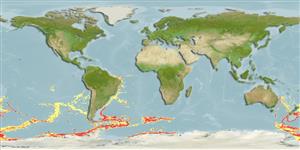Pycnogonida |
Pantopoda |
Nymphonidae
Environment: milieu / climate zone / depth range / distribution range
Ecology
Benthic; depth range 318 - 3000 m (Ref. 2116). Temperate
Southwest Atlantic, South Pacific and the Antarctic.
Length at first maturity / Size / Weight / Age
Maturity: Lm ? range ? - ? cm
Size moderately large, leg span about 82 - 92 mm. Most appendages very long, slender. Trunk and lateral processes well separated, glabrous. Neck of medium length, oviger bases implanted well anterior to first lateral processes, low ocular tubercle placed between oviger bases and first lateral processes. Proboscis rather long, slender, with slight median and distal swelling. Abdomen narrow, short. Xelifore scapes longer than proboscis. Chelae very slender, palms short, fingers very long, overlapping at tips, armed with very many slender sharp teeth. Palps quite slender, third segment about 0.6 length of second, fourth only slightly shorter than fifth (sometimes subequal). Oviger fifth segment longest, slender, distally curved and swollen. Second coxae of legs unusually long, about 4.5 times longer than first coxae. Second tibiae longest segments. Tarsus sometimes shorter, sometimes subequal to propodal length, claw 0.7 length of propodus, sometimes longer, without auxiliaries. Sole of both distal segments with many very short spines (Ref. 9).
Life cycle and mating behavior
Maturity | Reproduction | Spawning | Eggs | Fecundity | Larvae
Members of the class Pycnogonida are gonochoric and sexually dimorphic. During copulation, male usually suspends itself beneath the female. Fertilization occurs as the eggs leave the female's ovigers. Males brood the egg masses until they hatch. Life cycle: Eggs hatch into protonymphon larva then to adults.
Child, C.A. 1998. (Ref. 9)
IUCN Red List Status (Ref. 130435)
CITES status (Ref. 108899)
Not Evaluated
Not Evaluated
Threat to humans
Human uses
| FishSource |
Tools
More information
Age/SizeGrowthLength-weightLength-lengthMorphologyLarvaeAbundance
Internet sources
Estimates based on models
Preferred temperature
(Ref.
115969): 0.2 - 4.3, mean 2.8 (based on 605 cells).
Price category
Unknown.
